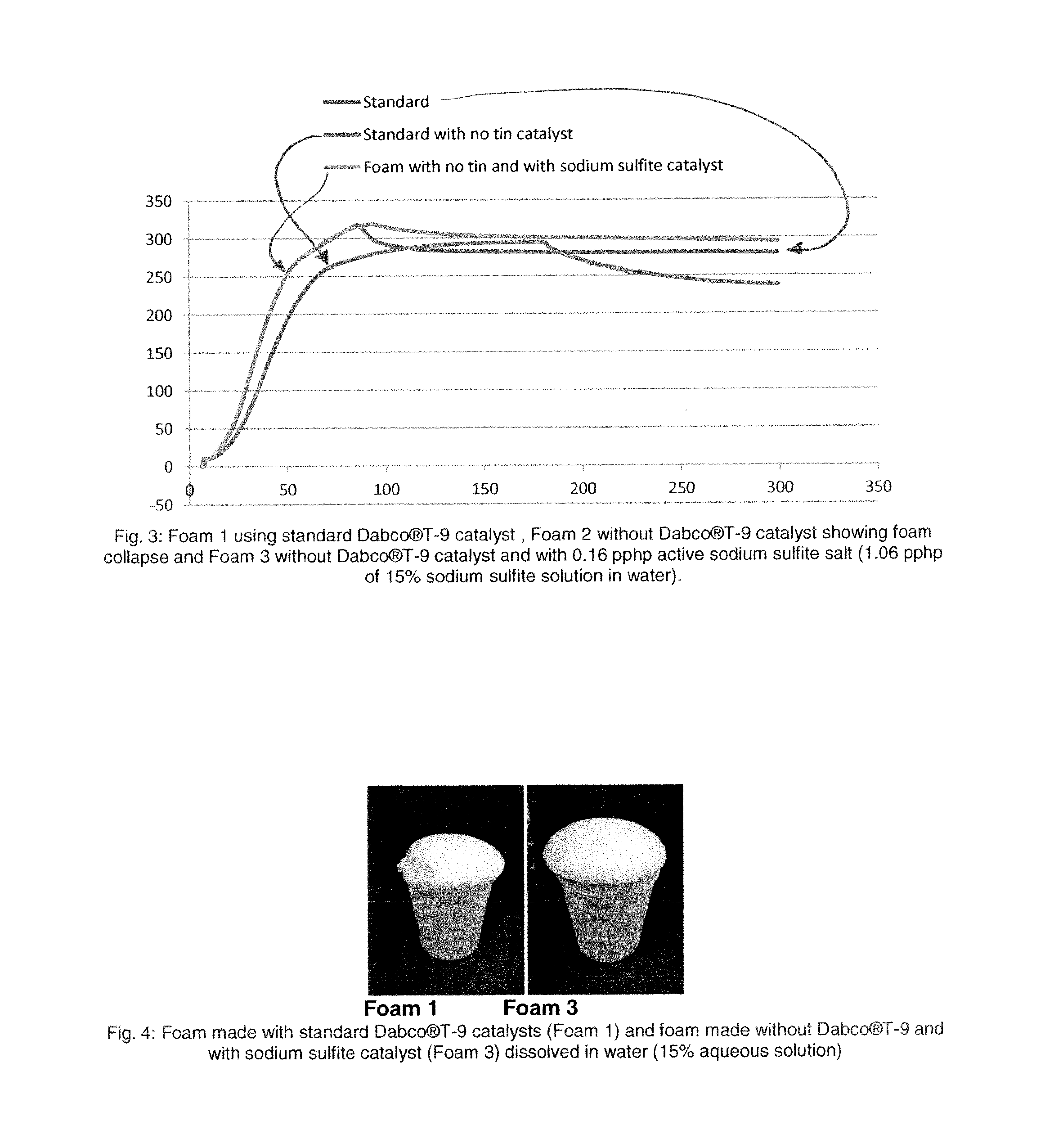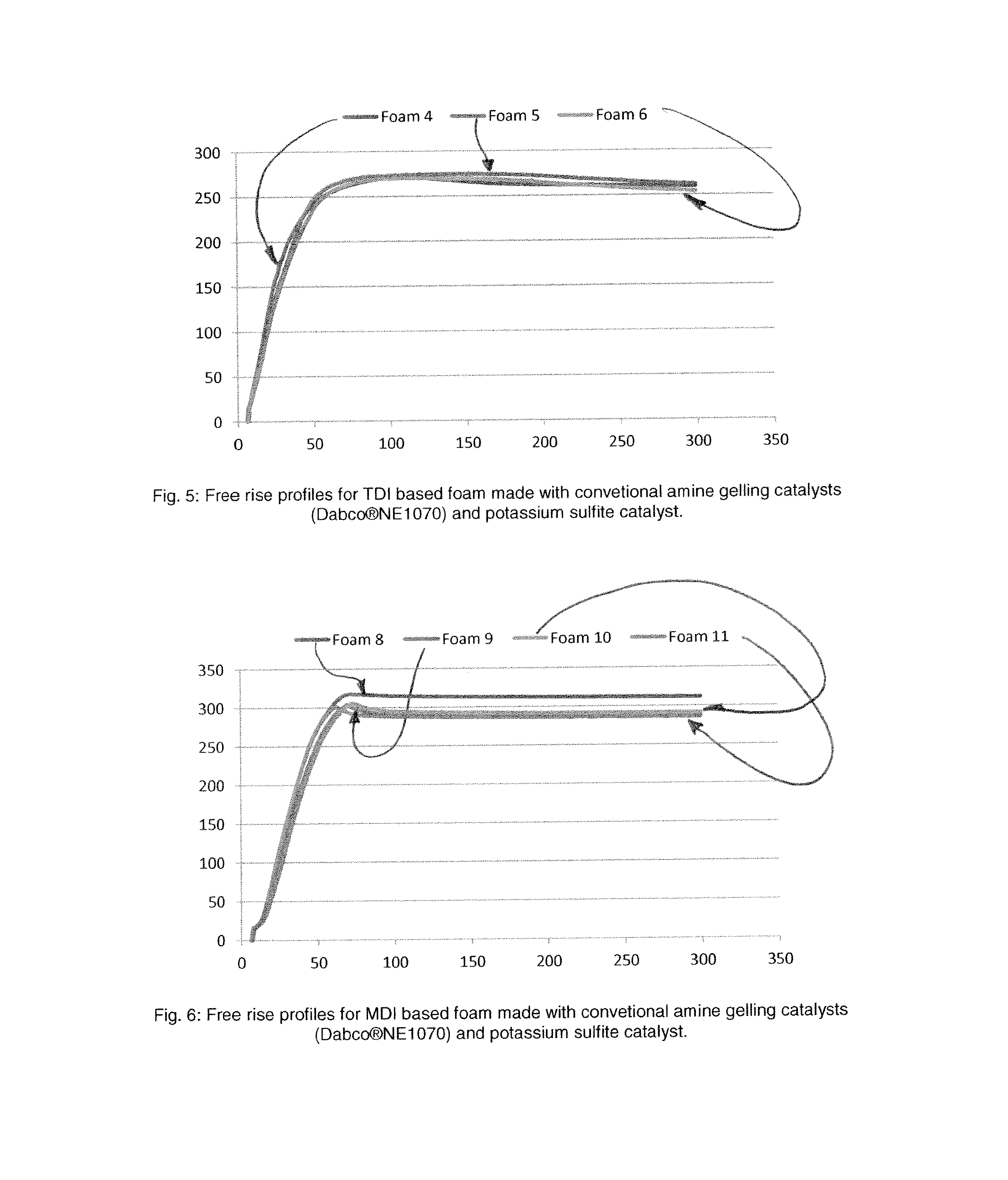Polyurethane Catalysts from Sulfur Based Salts
a technology of sulfur based salts and polyurethanes, which is applied in the direction of organic compounds/hydrides/coordination complexes catalysts, physical/chemical process catalysts, sulfur compounds, etc., can solve the problems of detriment to foam reactivity beyond the recommended use level, and achieve the effect of reducing or eliminating emissions and sufficient reaction rates
- Summary
- Abstract
- Description
- Claims
- Application Information
AI Technical Summary
Benefits of technology
Problems solved by technology
Method used
Image
Examples
example 1
Illustration of Foam Kinetic Data Obtained with and without Tertiary Amine Gelling Catalyst
[0069]Foaming performance can be evaluated by comparing the foam height versus time for standards and new amine catalyst. Foam height profile can be measured by automated rate of rise equipment, utilizing free-rise cup foam samples with a FOMAT sonar rate-of-rise device, model no V3.5 (hereafter referred to as a “ROR”). The FOMAT device comprises a sonar sensor that measures and records the height in millimeters (mm) of the rising foam sample versus time in seconds (s), directly after mixing all components of the formulation. The FOMAT standard software generates both height versus time plots and velocity versus time plots. These plots are useful for comparing the relative reactivity of different catalyst formulations. Flexible foam can be prepared by combining a total weight of about 300 g of the ingredients in Table 1 other than the isocyanate in a 32-oz (951 ml) paper cup. This premix formu...
example 2
Illustration of Foam Kinetic Data Obtained when Using Aqueous Solution of Sodium Sulfite
[0070]Flexible slabstock foam was prepared following the same procedure described for example 1. Table 2 shows the list of components needed to make flexible slabstock foam. Foam 1 was made according to a standard flexible slabstock formulation containing 0.16 pphp of Dabco®T-9 (Stannous octoate) as main gelling catalysts. Foam 2 does not contain Dabco®T-9 catalyst and it contains sodium sulfite as the main gelling catalyst. The sodium sulfite catalyst was added to the formulation as 15% solution in water. The rate of rise profiles in FIG. 3 shows that when Dabco®-T9 is completely replaced with 0.16 pphp of sodium sulfite added as 15% aqueous solution then the rate of rise curve for this foam exactly matched the rate of rise curve of the control formulation made with Dabco®-T9. Photographs of standard foam made with Dabco®T-9 and with sodium sulfite solution are shown in FIG. 4.
TABLE 2Foam 1Foam ...
example 3
Illustration of Foam Kinetic Data Obtained when Using Aqueous Solution of Potassium Sulfite to Make TDI Molded Foam
[0071]Free rise TDI based flexible molded foam samples were made following the same procedure described for example 1. Table 3 shows the list of components needed to make flexible molded foam samples like those commonly used in automotive car seating applications. Foam samples were made according to a standard flexible molded formulation containing reactive amines Dabco®NE1070 (mono- and bis-dimethylaminopropylurea) as main gelling catalysts and Dabco®NE300 (N,N,N′-trimethyl-N′-3-aminopropyl-bis(aminoethyl)ether) as main blowing catalyst. Table 4 shows the foam kinetic data comparison when tertiary amine gelling catalysts Dabco®NE1070 is replaced with potassium sulfite at various use levels. A faster string gel time is observed even at relatively low use levels of potassium of potassium sulfite relative to the standard demonstrating the effectiveness of potassium sulfit...
PUM
| Property | Measurement | Unit |
|---|---|---|
| wt. % | aaaaa | aaaaa |
| temperature | aaaaa | aaaaa |
| wt. % | aaaaa | aaaaa |
Abstract
Description
Claims
Application Information
 Login to View More
Login to View More - R&D
- Intellectual Property
- Life Sciences
- Materials
- Tech Scout
- Unparalleled Data Quality
- Higher Quality Content
- 60% Fewer Hallucinations
Browse by: Latest US Patents, China's latest patents, Technical Efficacy Thesaurus, Application Domain, Technology Topic, Popular Technical Reports.
© 2025 PatSnap. All rights reserved.Legal|Privacy policy|Modern Slavery Act Transparency Statement|Sitemap|About US| Contact US: help@patsnap.com



